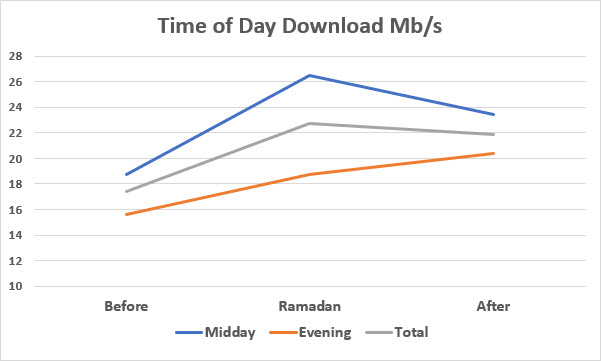Introduction
In 2019 7 million visitors arrived in Jeddah during Ramadan (5th May to 3rd June) compared to its normal population of between 4 and 5 million. Google’s own insight report shows that demand increases during Ramadan as well. In this report we examine how the MNOs (Mobile Network Operators) coped with this increased demand. We analyse speeds between 17th April through to the 13th June to compare average download speeds before, during and after Ramadan.
Ramadan, Jeddah and the Internet
Internet Use Peaks During Ramadan
Internet use in MENA (Middle East and North Africa) during Ramadan is higher than any other time of the year. Google internal data shows huge spikes across several content categories on YouTube throughout the holy month each year, including TV & Comedy, Cooking & Recipes, Religion & Spirituality, Gaming, Auto & Vehicles and Internet & Telecom. Here is a chart from Google’s report in 2015 showing demand for TV and comedy downloads rising during Ramadan and falling after Ramadan.
MENA YouTube Viewership Ramadan 2015 from Google:
This peak is further emphasised in Google’s 2017 Ramadan Insight report in which they show:
“Watch time for content related to ‘TV drama series’ rises a staggering 151% in Ramadan compared to any other period in the year”
Google’s statistics are backed up by reports of increased smartphone usage during Ramadan such as this article from Mid East Information: Major surge in smartphone usage expected during Ramadan in KSA.
“Ramadan is one of the most active times of the year for social media in the Middle East – on all social media channels – as Muslims reach out to friends and family, prepare for the holy month, and celebrate in the run up to Eid.”
Jeddah Welcomes 7 Million Visitors
The Kingdom of Saudi Arabia issued over 7 million Umrah visas for 2019 and as of May 2019 6,964,943 have arrived in the Kingdom. Most of these will arrive in Jeddah because Jeddah airport is the gateway to the capital of the Kingdom of Saudi Arabia and it is the national air transport center.
Methodology
We analysed data before, during and after Ramadan between 17th April and 5th June. This data was restricted to include only data that was:
- Within the city of Jeddah
- Cellular only (not fixed)
- Provided via the top 3 MNOs operating in Jeddah (STC, Mobily and Zain)
- Midday (12 to 2pm) or Evening (8pm to 10pm)
Jeddah was chosen because the number of visitors expected to pass through during this time could be expected to have a significant impact on the service provided by MNOs. We were keen to see how the MNOs coped during this time.
We chose to limit to cellular because this is the type of connection most likely to be used by visitors as well as local residents and therefore more likely to be impacted.
The top 3 MNOs (STC, Mobily and Zain) were chosen because they account for almost all connections in Jeddah.
We chose evening because we anticipated the demand to be high during those hours. Midday was chosen to compare the quality of service during two different parts of the day with different demands on the Internet.
Results
STC and Mobily achieved the best results with nothing to choose between them. Although Zain achieved lower speeds credit is given for sustaining their performance during this spike in demand.
We were also interested to see how performance varied during the day from the quiet of midday to the peak viewing / download time of the evening. Here we see that the speed in the evening was always well below the speeds achieved during the day. Even so, the evening speeds improved by 30% during Ramadan.
For Hajj last year (2018) the King Salman bin Abdulaziz and the Crown Prince Mohammed bin Salman issued a directive “to do everything possible to make it easy for pilgrims to perform the rituals of Hajj”. The initiative’s objective was to allow pilgrims to communicate with their families and enable them to access the digital services available in the Smart Hajj initiative. This was a great access as seen in our report from last year.
Although we didn’t see any similar initiatives being advertised in Jeddah during Ramadan it appears from our results that efforts have been made by MNOs and the Kingdom to sustain performance during this high demand.
Conclusion
We expected to see that as more and more people arrived in or passed through Jeddah during Ramadan that the speeds achieved would fall and then return to previous levels as the demand diminished. However, all three MNOs achieved remarkable results showing an increase in measured speeds during Ramadan compared to the weeks before. Although there was some reduction in speed after Ramadan it seems to have sustained a higher level than before. As discussed previously, the increased demand for Internet was predicted well in advance giving MNOs ample time to prepare. We can only assume that they used this time wisely and their customers (and guests) reaped the benefit.
It is heartening to see that there seems to be a residual benefit to customers of all three MNOs with the speeds after Ramadan being higher than before (if not quite as high as experienced during Ramadan).



